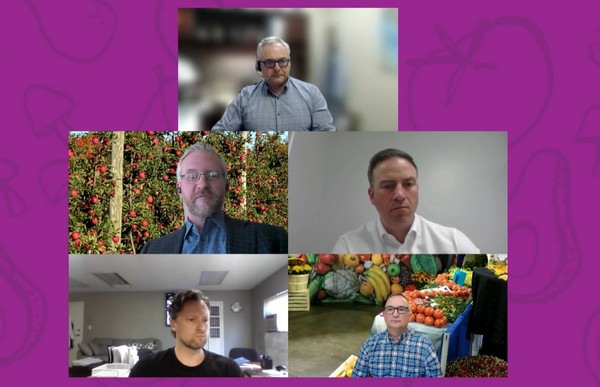Following what many say could be the most challenging year for their businesses, where does that leave the future of foodservice?
Yesterday’s CPMA virtual town hall looked deeper into this subject.
While pivot may be a bit of an “it” word in the pandemic, it certainly applies to the kind of approach many foodservice establishments had to take. “If your business wasn’t set up to respond to take out very well, you had to make a lot of changes,” says Tom Bak of Etobicoke, ON-based Sysco Canada. That began by removing “nice-to-haves” and focusing on “must-haves.” “That was vegetables, fruit, fresh product that could be adapted to freezer/take-home applications in quantities that they could purchase them in,” says Bak. Rather than carrying large inventories, foodservice clients wanted smaller pack sizes with new delivery schedules. “In our healthcare business for example, customers wanted fewer deliveries with fewer people coming into their buildings,” says Bak.
For JP Potters of the Boulevard Kitchen & Oyster Bar in Vancouver, BC, the pandemic helped Boulevard focus on core value propositions. “Over time, restaurants have added a lot of things to be unique and operations got very bloated,” says Potters. This includes even examining the number of meal services it offered. “When we shed meals like breakfast and lunch, how much more profitable was the business? We always hypothesized it’d be more robust but we didn’t have the opportunity before to walk away from breakfast or lunch.”
New possibilities emerged
At the same time, new opportunities presented themselves. Boulevard launched Provisions, an online program giving consumers access to high-end proteins, specialty goods, stocks and more. “It’s a multiplier for us now that we’re reopened,” says Potters. “It allows us a supplemental income stream. It was a game-changer for us to make a sale when someone wasn’t in the restaurant.”
 Top: Mario Masellis of M.L. Catania Co. Ltd.; Middle left to right: Steve Bamford, Fresh Advancements, JP Potters of the Boulevard Kitchen & Oyster Bar; Bottom left to right: Craig Sheridan, Legends Haul, Tom Bak, Sysco Canada
Top: Mario Masellis of M.L. Catania Co. Ltd.; Middle left to right: Steve Bamford, Fresh Advancements, JP Potters of the Boulevard Kitchen & Oyster Bar; Bottom left to right: Craig Sheridan, Legends Haul, Tom Bak, Sysco Canada
Legends Haul in Coquitlam, BC developed an e-commerce site and worked with its restaurant partners to creating “heat and eat” lines and other value-added products consumers didn’t have access to at their grocery stores. “It’s become a large piece of who we are and today 50 percent of our business is in e-commerce grocery store,” says Craig Sheridan of Legends. “We’ve had to lease a new facility, we have 40 staff and we have 13 trucks on the road and close to 20,000 homes we service.”
New clients also emerged. Bak says Sysco began selling smaller pack sizes to Indigenous communities. “They were under serviced and it was a chance to bring in fresher, better product,” he says. “It was also a reaction to the uncertainty around provincial legislation and what portion of their business they could operate. Nobody wanted to rest on a large inventory because of the uncertainty.”
As for consumers though, how have they changed? And how will their demand change?
First up is consumers and technology. “It’s changed the way consumers interact with brands--think about the way QR codes have been integrated,” said Sheridan. “Consumers want to know how it’s grown, where it’s grown and more. They’re more educated now.”
The role of local
The interest in local food has also grown. “At this point, local isn’t something that’s nice to have. It’s an expectation for consumers now,” says Bak.
Other expectations have also changed. “There’s pent-up demand for people getting out so there’ll be a shift from good enough to exceptional whether it’s on the produce side, the restaurant side or more,” says Potters. “They’ll go out and spend that money and they’re going to demand a more exceptional product.”
So where does this leave growers-shippers? How can produce be a partner to foodservice establishments contending with all of these changes?
It may start with value-added products. “Tight labor is going to force everyone to reexamine their processes. In the short-term, we see an increase in value-added products in the business. As we can bring people back, then you may see a more traditional product,” says Bak.
Going back to convenience?
Sheridan agrees. “A few years ago, people wanted to play with product and get creative in the kitchen. I think it’s going to revert back to convenience and managing food costs proportionately to the experience,” he says.
This also may be a time to consider the structure of foodservice meals. “Producers need to think about positioning produce as the primary item on plates rather than letting protein be the star of the show as it’s traditionally been,” says Potters. “The market is ready for local, healthy products that are more plant-based.”
That also means educating foodservice clients. “Trends have been sped up via the pandemic--healthy eating and plant-based. If you can be there to help educate and bring new products to market, you could be a great resource for foodservice establishments,” adds Sheridan.
